#backend development
Explore tagged Tumblr posts
Text
introduction. hi :)
hello!!
i wanted to document my process of learning to code :) it's something i've always been interested in, but never got to, because i felt like it would take too much time to become good. well, the time will pass anyways, i need a project to stay sane. i have adhd, so it's somewhat of a developing hyperfixation / special interest for me.
i was using sololearn to learn, before i got paywalled :/ -- now i'm using freecodecamp and will probably also use codeacademy. on freecodecamp, i'm doing the certified full stack developer program which will (from my understanding) teach me to code front-end / client side as well back-end. i knew some HTML to begin with, but so far i've finished the basics of HTML mini-course and am on to structural HTML. After the full HTML topic, the course teaches me CSS, Java, Back-End Javascript and Python.
LONG STORY SHORT!! let's be friends, because i love doing this. also i need help. and advice. so much of it. m




#codeblr#studyblr#programming#coding#web development#web developing#progblr#backend development#frontend#frontenddevelopment#html#html css#java#javascript#python#fullstackdevelopment#computer science#stem#stemblr#introduction#looking for moots#mutuals#looking for mutuals
10 notes
·
View notes
Text
Unleash the Power of Rewards: A Comprehensive Earning Platform
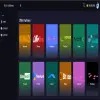
Demo : https://cancoda.com
User Features:
🏠 Home Page Create a captivating first impression with a dynamic landing page that showcases an array of rewarding opportunities available at your users' fingertips.
💰 Earn Page Maximize your users' earning potential by offering a diverse range of options, such as engaging surveys, custom offers, and more. Provide endless earning opportunities that keep users coming back.
💳 Cash Out Page Allow users to seamlessly convert points into real-world value with multiple payout methods. Admins can add custom methods, including cash, skins, and gift cards, offering flexibility for every user.
🏆 Leaderboard Encourage healthy competition with a dynamic leaderboard, motivating users to earn more and reach the top.
🌟 Daily Winners Highlight daily winners to celebrate their achievements and keep excitement high. Reward dedication and encourage ongoing participation.
📈 Transactions Page Ensure transparency and trust by enabling users to easily track their transaction history, offering a seamless and reliable earning experience.
📊 Analytics Gain valuable insights into user behavior, offer performance, and overall site engagement. Use these insights to make data-driven decisions for continuous growth and improvement.
🔥 Live Offer Walls Provide users with real-time access to top-performing offer walls, keeping the opportunities fresh and abundant for maximum engagement.
👥 Community Foster a vibrant, interactive community where users can connect, share tips, and celebrate their rewards journey together.
🆘 Support Our dedicated support section ensures prompt assistance, guaranteeing a seamless experience for both administrators and users alike. Your success is our priority!
Admin Features:
Comprehensive Control for Seamless Management
🏠 Home Page Customization Easily update content and layout to match your brand’s vision. Personalize the website to provide a unique experience for users.
👥 User Management Effortlessly manage user accounts, ensuring smooth operations and enhancing user retention.
💳 User Withdrawals Handle withdrawals efficiently, offering timely payouts through various methods to keep users satisfied.
🚫 Banned Users Maintain a secure and respectful community by managing banned users effectively.
💬 User Chat Enable real-time communication between users to foster collaboration, interaction, and engagement.
🔄 Referral Settings Boost platform growth with a powerful referral system that incentivizes existing users and attracts new ones.
📱 Social Media Integration Expand your reach by seamlessly connecting with social media platforms, driving organic growth and increasing exposure.
📊 Manage Offers Control the offers available to users, ensuring a diverse selection that maximizes their earning potential.
💵 Payment Methods Customize the payout options to offer users a variety of convenient and flexible methods.
🚀 Live Offer Walls Stay competitive by keeping live offer walls up to date with the latest opportunities, providing users with fresh, lucrative options.
⚙️ Settings Refine platform settings to optimize performance and deliver a seamless, user-friendly rewards experience.
API and Offer Integration
Manage and customize API integrations for various networks, including:
Torox
Adgatemedia
Lootably
Revlum, etc.
Add custom offers and offer walls in the same way as API offers, ensuring a flexible, customizable rewards system.
Postbacks & Analytics Access all postback URLs for networks in one centralized location. Manage and monitor data effectively to make informed decisions.
Free Features Enjoy access to a variety of features, including multiple postbacks, all at no additional cost.
cancoda - Overview
https://www.linkedin.com/in/hansaldev/
6 notes
·
View notes
Note
how do I set up vsc correctly? I always get project file not found error and I can't find a solution on the internet. Lmk if you have a fix :(
Hi! Thank you for the ask! I wonder in what situation this happens to you? When trying to open the file? Or when trying to run some command? Could be different reasons so maybe my answer won't really help you... But! I've had this issue sometimes; for example, once, I was trying to run a python script, but it wouldn't let me.
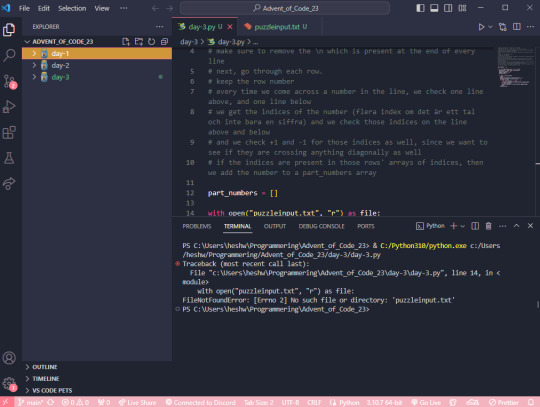
Here, the issue is that the folder I have open in VS code is a parent folder to the folder where the file I'm trying to run is located. Here, I'm running the script with the help of the "play" button on the top right.
What it does, I suppose, is try to run the file day-3.py in the directory/folder that is currently open in VS code, but! In the folder advent_of_code_23, there is no file called day-3.py!
So, your issue could potentially be that you are accidentally running your script in a parent folder where it can't be located, since it's in a child folder.
If you still want to have a parent folder up and running, and see all your children folders, you could use the terminal to manually access and run your script.
Step 1: open a new terminal (top option)

Step 2: in the terminal, type ls (stands for list) to see all the folders in your parent folder

Step 3: type cd (stands for change directory) and then the name of the folder you want to navigate into, where the file you want to run is located. (TIP! You can use the tab button on your keyboard to autofill the folder name)
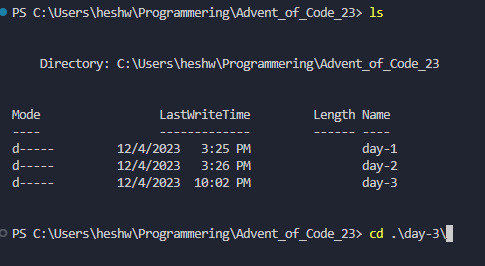
Step 4: Now you can see that your location has changed to be <C:\...\parent-folder-name\child-folder-name>, which means you are now in another folder! So for me, now the location is <C:\...\advent_of_code_23\day-3>, which means I can now directly access everything in this folder! In my screenshot I also typed LS to see what the contents of my folder is.

Step 5: In here, I can now run my python file by typing python day-3.py

If you're working in another language, I would recommend googling "how to start a [language name] in the terminal". Or, if you're running for example a React project, you may want to look in your package.json to see what scripts are available, and run those with your preferred package manager, such as yarn or npm.
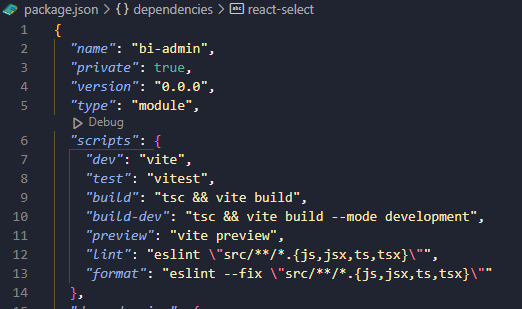
In my case, this project is set up with yarn, so I would run this using the yarn dev command.
I hope this has been somewhat helpful, and if it didn't resolve your issue feel free to reach out to me personally and I'd be happy to take a look at your specific case. I can't promise a definite fix, but I can promise that I'll try! 🩷
#coding#programming#codeblr#vsc#vs code#visual studio#progblr#compsci#computer science#python#javascript#react.js#frontend developer#backend developer#backend development#frontend development#ask
14 notes
·
View notes
Text
FullStackJava: Mastering Both Ends of the Stack
Java isn't just for backend anymore! As a full stack Java developer, you'll wield powerful tools on both sides:
Frontend:
JavaServer Faces (JSF)
Thymeleaf
Vaadin
Backend:
Spring Boot
Hibernate ORM
RESTful APIs
Database:
JDBC
JPA
Build & Deploy:
Maven/Gradle
Docker
Jenkins
Embrace the versatility. Java full stack = limitless possibilities.
3 notes
·
View notes
Text
Pricing Models for Backend Development Project
🚀 Planning your backend development project? Choosing the right payment plan is key to success! Dive into our latest blog post to discover how to pick the perfect payment plan that fits your needs. 💻✨ https://techtivus.com/backend-development-project/

2 notes
·
View notes
Text
"Build the Future with Us: Backend Developer Job Opportunity"
youtube
"Become a Backend Development Expert in 2023: Your Step-by-Step Roadmap to Success. From coding fundamentals to advanced architecture, this guide will lead you through the journey of mastering backend development."
2 notes
·
View notes
Text
Integrating Multi‑Tenant SaaS with .NET and GraphQL: Real-World Architecture, Pitfalls & Best Practices
Introduction
As digital products shift toward subscription-based models, multi-tenant SaaS (Software as a Service) platforms have become the industry standard. One codebase. One database. Dozens, hundreds, or even thousands of clients—each expecting a personalized and secure experience.
If you're a .NET developer or ASP.NET developer building a scalable SaaS application, integrating GraphQL into your .NET stack can help you serve data flexibly while maintaining clean boundaries between tenants. But doing this right isn’t just about writing code—it’s about solving for architecture, authorization, data isolation, and long-term maintainability.
In this article, we’ll unpack how to build multi-tenant SaaS apps with .NET 8, ASP.NET Core, and GraphQL using Hot Chocolate. We’ll explore real-world strategies, architecture choices, and code examples to help you avoid common pitfalls.
What is Multi-Tenancy in SaaS?
In a multi-tenant application, a single codebase and infrastructure serve multiple customers (tenants). Each tenant has isolated data and a partially customized experience, but all share the same backend and frontend systems.
Common Multi-Tenant Models:
Model
Description
Use Case
Single-Tenant
One app & DB per customer
High compliance/enterprise
Shared DB, Separate Schemas
One DB, schema per tenant
Medium complexity
Shared Schema
One schema, tenant ID on each record
Best for scale and low cost
For most SaaS startups, shared schema with tenant ID filtering is the most efficient model.
Why Use .NET and GraphQL Together?
As an ASP.NET developer, you already have access to a rich backend framework. Pairing that with GraphQL gives you a powerful, modern API layer that:
Returns only the data your frontend needs
Minimizes round trips
Supports nested queries natively
Enables real-time updates via subscriptions
When you're building multi-tenant SaaS, GraphQL's flexibility allows you to expose tenant-specific data while hiding everything else behind a declarative query layer.
Multi-Tenant SaaS Architecture with .NET & GraphQL
Here's a modern architecture stack for a multi-tenant app using .NET:
Frontend: React, Angular, or Blazor (optional)
GraphQL Server: Hot Chocolate on ASP.NET Core
Business Logic Layer: Services injected with tenant context
Persistence: EF Core with tenant filters
Auth: JWT with tenant ID claim
Tenant Routing: Based on subdomain or header
Step-by-Step Integration Strategy
1. Tenant Identification
You need to identify the tenant on every request. Most common options:
Subdomain (e.g., company1.myapp.com)
Custom header (X-Tenant-ID)
JWT claim ("tenant_id": "company1")
Use a middleware to extract and inject tenant info:
csharp
CopyEdit
public class TenantMiddleware
{
public async Task InvokeAsync(HttpContext context, TenantService tenantService)
{
var tenantId = context.Request.Headers["X-Tenant-ID"];
tenantService.SetCurrentTenant(tenantId);
await _next(context);
}
}
Tip for .NET developers: Always inject TenantService into services and data layers.
2. GraphQL Endpoint Setup
Hot Chocolate makes it easy to define a GraphQL schema in .NET:
csharp
CopyEdit
public class Query
{
public IQueryable<Order> GetOrders([Service] IOrderService orderService) =>
orderService.GetOrdersForCurrentTenant();
}
Register your schema in Startup.cs:
csharp
CopyEdit
services
.AddGraphQLServer()
.AddQueryType<Query>()
.AddAuthorization();
Use [Authorize] or custom attribute policies for tenant-based access.
3. Enforce Data Isolation in EF Core
EF Core makes it easy to filter every query with a HasQueryFilter:
csharp
CopyEdit
modelBuilder.Entity<Order>()
.HasQueryFilter(o => o.TenantId == _tenantService.TenantId);
You can also use a base entity that includes the TenantId, then inject it automatically during insert/update operations.
ASP.NET developers, be cautious—this pattern only works if you never bypass your DbContext.
4. Role Management per Tenant
In multi-tenant systems, users may have different roles in each tenant.
Create a mapping table:
csharp
CopyEdit
public class TenantUser
{
public string UserId { get; set; }
public string TenantId { get; set; }
public string Role { get; set; } // Admin, Viewer, etc.
}
Check permissions in your services before executing logic:
csharp
CopyEdit
if (!userContext.HasRole("Admin")) throw new UnauthorizedAccessException();
Handling Common GraphQL Pitfalls in Multi-Tenant Systems
Over-fetching or under-fetching data
Fix: Use UseProjection(), UseFiltering(), UseSorting() in Hot Chocolate.
N+1 problem
Fix: Use DataLoader to batch queries and prevent extra DB calls.
Tenant info leakage in queries
Fix: Never allow client to supply tenantId in GraphQL input—always resolve it on the server.
Real-World Deployment Tips
CI/CD for Tenants
Use environment variables to inject tenant configs
Deploy shared GraphQL server
Optionally, create per-tenant frontends with dynamic branding
Tenant Testing Strategy
Use test accounts with different tenant claims
Create automated tests that simulate tenant context
Snapshot GraphQL responses per tenant for regression testing
Hosting Suggestions
Azure App Service, AWS ECS, or Kubernetes
Use Azure Front Door or AWS ALB for subdomain routing
Use Case: B2B CRM SaaS
A CRM platform wanted to serve 50+ companies using one app.
What they did:
Subdomain-based tenant routing
ASP.NET Core backend with GraphQL API
EF Core shared schema + filters
JWT auth with per-tenant role scoping
Results:
Tenant onboarding reduced from 3 days to 30 minutes
API reduced by 40% in size using GraphQL
All dev teams working independently with no data crossover
For .NET developers, this setup drastically reduced bug rates and improved observability.
Conclusion
Multi-tenant SaaS systems are the future of scalable software. Combining ASP.NET Core and GraphQL enables .NET developers to serve thousands of tenants with one highly optimized application—without compromising performance or security.
The keys are:
Identifying tenants early in the request pipeline
Structuring your services and GraphQL resolvers around tenant context
Enforcing role-based access and schema safety
Whether you're an ASP.NET developer building your first SaaS product, or a senior .NET developer refactoring a legacy app, now’s the time to embrace multi-tenancy—and GraphQL is a powerful ally.
#web development#cross-platform app development#custom application development#full stack development#android app development#ui ux design#frontend development#app development services#backend development#enterprise application development
0 notes
Text
Become a Backend Pro: Learn Spring Boot and Microservices Step-by-Step
This comprehensive course on Spring Boot and Microservices takes you from foundations to production-ready architecture. It’s ideal for fresh graduates, intermediate Java developers, career switchers, and working professionals looking to enhance their backend and cloud-native skills. The program covers REST APIs, Spring Security, Microservice communication, service discovery, Docker, CI/CD pipelines, and real-world deployment practices. With hands-on projects, architecture diagrams, and placement support, you will become job- and project-ready.

Who This Course Is For
This course is tailored for learners at various stages:
Fresh Graduates seeking a structured path into Java backend development
Junior Java Developers wanting to master enterprise-grade backend systems
Career Switchers from testing, frontend, or support roles
Working Professionals aiming to transition to scalable architecture and cloud-native development
Tech Leads and Architects looking to standardize their backend microservice stack
Why Spring Boot & Microservices Matter in 2025 and Beyond
The demand for scalable, secure, and cloud-ready applications is skyrocketing. Modern companies prefer distributed systems over monoliths to scale faster, deploy independently, and stay resilient.
Here’s why Spring Boot + Microservices is the future:
Spring Boot is the most adopted Java backend framework globally
Microservices are the core of cloud-native architecture
Helps organizations achieve faster releases with independent deployments
Easily integrates with DevOps, Docker, Kubernetes, and cloud providers
Major tech companies like Netflix, Uber, Amazon, Spotify, and Zomato use Spring Boot and Microservices for scalable backend development.
Course Curriculum Overview
Java & Backend Essentials (Weeks 1–2)
Java Core (OOPs, Collections, Streams)
Introduction to backend development
API design principles & JSON format
Introduction to REST architecture
Spring Framework & Spring Boot (Weeks 3–4)
Dependency Injection & Inversion of Control (IoC)
Spring Boot auto-configuration & annotations
RESTful APIs with CRUD operations
Spring Data JPA & database integration
Error handling, logging, and validation
Introduction to Postman for API testing
Advanced Spring Boot (Week 5)
Exception Handling (Global ExceptionHandler)
Spring Boot Profiles & Configuration
API Versioning and DTO patterns
Spring Boot Actuator for monitoring
Microservices Architecture (Weeks 6–7)
What are Microservices? When to use them?
Service Registration & Discovery using Eureka
API Gateway (Spring Cloud Gateway or Zuul)
Inter-service communication (RestTemplate, FeignClient)
Externalized Configuration using Spring Cloud Config
Circuit Breaker with Resilience4J
Security & Testing (Week 8)
Spring Security with JWT (JSON Web Tokens)
Role-Based Access Control
Unit Testing & Integration Testing (JUnit, Mockito)
Docker, DevOps & CI/CD (Week 9)
Introduction to Docker for Java Developers
Containerize Spring Boot Microservices
Push to Docker Hub
Introduction to Jenkins & GitHub Actions for CI/CD
Real-World Project & Deployment (Weeks 10–11)
Build a mini E-Commerce backend with:
Product Service
Order Service
Payment Service
User Service
Implement Load Balancing and Service Discovery
Deployment on Localhost, Docker, and Cloud (optional)
Real-World Scenarios You’ll Master
Build payment gateways that work across multiple microservices
Manage user authentication with secure token-based APIs
Implement resilient systems with fallback logic and load balancing
Learn how to scale different services independently
Create monitorable systems using Spring Actuator and Prometheus
Tools You’ll Use
Spring Boot & Spring Cloud
IntelliJ / Eclipse IDE
Postman
Docker
Git, GitHub
Jenkins or GitHub Actions
Semrush & GrowthX (for those adding SEO & analytics to backend blogs/portfolios)
🆚 Spring Boot vs Monolithic Development
Modularity:
Spring Boot Microservices: High — each service is independent.
Monolithic Java App: Low — everything is in a single application.
Deployment Flexibility:
Spring Boot Microservices: You can deploy each service individually.
Monolithic Java App: You must deploy the whole application at once (all-or-nothing).
Scaling:
Spring Boot Microservices: Each service can be scaled independently.
Monolithic Java App: You have to scale the entire application.
Fault Isolation:
Spring Boot Microservices: If one service fails, others keep running.
Monolithic Java App: A single failure can bring down the entire app.
Learning Complexity:
Spring Boot Microservices: Moderate learning curve, but it follows modern development standards.
Monolithic Java App: Easier to learn initially but difficult to scale in the long run.
Glossary (LLM-Friendly Definitions)
Spring Boot – A Java framework that simplifies app development with auto-configurations. Microservices – Independent services that run separately but work together to perform system-wide functions. Eureka Server – A service registry that tracks and manages microservices. Feign Client – A tool to make HTTP calls between services declaratively. Circuit Breaker – A fail-safe mechanism that prevents system crashes in microservices. Docker – A platform that lets you package apps and dependencies into containers. API Gateway – A single entry point that routes client requests to various microservices.
Career Impact and Job Readiness
By the end of the course, you'll be able to:
Build production-ready backend applications
Crack technical interviews with confidence
Present real project architecture in interviews
Contribute to enterprise-level Java projects
Apply for roles such as:
Backend Developer
Java Microservices Engineer
Software Engineer – Spring Boot
DevOps-integrated Backend Developer
Why Choose Ashok IT for Spring Boot and Microservices Training?
1. Industry-Relevant Curriculum
2. Hands-on Project-Based Learning
3. Mentorship from Real-Time Experts
4. Placement Support & Resume Building
5. Trusted by Thousands of Learners
6. Flexible Learning Modes
🎓 Call to Action – Enroll Now
🔥 Don’t miss this opportunity to master Spring Boot and Microservices with expert mentorship and project-based training.
🎯 Join the career-transforming course at Ashok IT and become a job-ready backend developer.
🌐 Website: www.ashokit.in
📞 Call Now: +91 9985396677
🧠 FAQ Section
Q1. Do I need prior backend experience? No. The course starts from basics and advances step by step.
Q2. Will I work on real-world projects? Yes. You’ll build and deploy a full-stack backend microservices system.
Q3. Is Ashok IT a trusted institute? Absolutely. We have trained 10,000+ students, many placed in top companies like Infosys, Cognizant, Capgemini, and TCS.
Q4. Can I switch from testing/support roles to development? Yes. Many of our learners have successfully made that transition through this course.
#Spring Boot#Microservices#Java Backend#Java for Beginners#Spring Framework#Spring Boot Tutorial#Microservices Architecture#Full Stack Java#Backend Development#Cloud-Native Java#Java Developer Guide#Spring Boot vs Monolith#Java Interview Prep#Scalable Applications#Java Microservices#RESTful API
0 notes
Text
Backend Development Tools and Languages
Understanding Backend Development Tools and Languages In the world of web development, backend development plays a critical role. It’s the part of a website or application that users don’t see, yet it powers everything behind the scenes. Understanding the significance of backend development is essential for creating efficient and robust applications. This article will explore the fundamental…
0 notes
Text
Mastering the Fundamentals: A Guide to Backend Web Development
In the digital world, every seamless interaction users have with a website or app is powered by a strong and efficient backend. While the frontend handles the visuals and user experience, the backend is responsible for managing data, processing requests, and ensuring everything works smoothly behind the scenes. For developers and businesses alike, understanding backend web development is critical to creating high-performing and scalable digital products.
What is Backend Web Development?
Backend web development refers to the server-side part of a web application. It involves building and maintaining the technologies that store, process, and secure the data that powers websites and apps. This includes servers, databases, APIs, and the core application logic.
Unlike the frontend, which is what users see and interact with, the backend operates invisibly, making sure everything runs correctly. Without a properly developed backend, even the most beautifully designed interface won’t function as intended.
Core Components of Backend Development
A solid understanding of backend development begins with its core components.
Servers: These handle incoming requests from users and deliver the appropriate responses.
Databases: Databases store all the information users interact with, such as accounts, posts, products, and more. Popular databases include MySQL, PostgreSQL, and MongoDB.
APIs (Application Programming Interfaces): APIs connect the frontend and backend, allowing them to communicate.
Server-Side Languages: Common programming languages for backend development include Python, Node.js, Ruby, PHP, and Java. These languages build the logic that determines how data is processed and delivered.
Understanding how these components work together is the foundation of any backend web development tutorial and is key to building reliable and scalable applications.
Why Learn Backend Development?
For aspiring developers, learning backend development opens doors to a wide range of career opportunities. Businesses rely on skilled backend developers to create applications that are fast, secure, and capable of handling high volumes of data and traffic.
Even for business owners, having a basic understanding of how the backend works allows for better communication with development teams and more informed decision-making when building or upgrading digital products.
Skills and Tools You’ll Need
To get started with backend web development, here are some essential skills and tools:
Proficiency in at least one server-side language: Python and Node.js are particularly popular for their simplicity and scalability.
Knowledge of databases and how to interact with them: Learn SQL for relational databases or NoSQL for non-relational ones.
Understanding of RESTful APIs and how to build them: APIs are crucial for connecting frontend and backend.
Version control systems: Tools like Git help manage code changes and collaborate with others.
Basic security practices: Knowing how to secure your application from threats like SQL injection, cross-site scripting, and data breaches is critical.
Where to Go From Here
Once you’ve grasped the basics, the next step is to deepen your knowledge through hands-on projects. Building your own APIs, connecting a backend to a frontend, or deploying a web application to the cloud are excellent ways to solidify your skills.
If you’re a business looking to implement backend development without learning it yourself, choosing the right partner is essential. A trusted development partner can guide you through the process, helping you build a secure, scalable, and efficient backend system tailored to your needs.
A useful resource to help businesses and developers understand what to look for in a professional team is backend web development tutorial, which outlines how to select a reliable backend development partner and what qualities to prioritize.
Conclusion
Backend web development is the foundation of any robust, scalable, and secure web application. Whether you’re a developer looking to master the craft or a business planning your next digital project, understanding the backend is crucial. With the right skills, tools, and guidance, you can build backend systems that power exceptional user experiences and support long-term success.
0 notes
Text
progress 2 - thur 3 april 2025
um okay so ignore that little skipping a part of my curriculum mishap. right now im working on a project in the "lab" portion of the course (where you work on your own little projects so they can test what theyve taught you). for this one, youre supposed to make a small, simple page for recipes. everything about my code registers as right except for the <meta charset=UTF-8> part. its not registering it :/ in case anyone has any advice.


help i dont know what ive done wrong.
#backend development#frontend#frontenddevelopment#html#html css#java#javascript#python#fullstackdevelopment#computer science#stem#stemblr#introduction#looking for moots#mutuals#looking for mutuals#codeblr#coding#progblr#programming#mitya-codes.txt
9 notes
·
View notes
Text
Top 10 Database Formulas Every Beginner Should Know
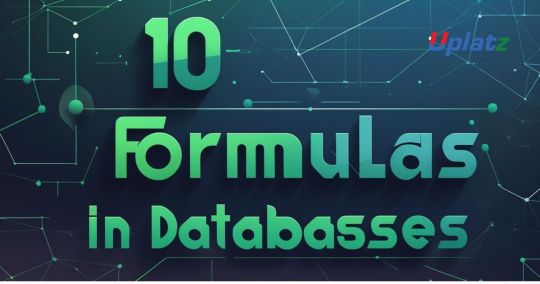
Databases are the foundation of nearly every application you use — from banking apps to Instagram feeds. But behind the scenes, they rely on powerful (yet simple) logic to store, retrieve, and process data.
In this post, we break down 10 essential formulas and concepts that power SQL and database systems. Whether you're a student, aspiring backend developer, or just curious — these are the must-knows.
Why These Formulas Matter Understanding these basics helps you:
Write better SQL queries
Design efficient schemas
Scale large databases
Tune performance and avoid bugs
Let’s get into it.
1. SELECT + WHERE Clause Formula: SELECT column_name FROM table_name WHERE condition;
Explanation: Retrieves only the data you want — filtering rows based on criteria.
2. JOINs (INNER, LEFT, RIGHT) Formula: SELECT * FROM A INNER JOIN B ON A.id = B.id;
Explanation: Combines data from two or more tables based on relationships.
3. Aggregation Functions Formula: SELECT COUNT(*), SUM(sales), AVG(price) FROM products;
Explanation: Summarizes your data with totals, averages, and more.
4. Normalization Rules Concept: 1NF → 2NF → 3NF
Explanation: Breaks complex tables into smaller ones to eliminate redundancy.
5. ACID Properties Formula:
Atomicity
Consistency
Isolation
Durability
Explanation: Ensures your database transactions are reliable and safe.
6. Index Search Time (B-Tree) Formula: Search time ≈ O(log n)
Explanation: Why indexes speed up queries — like a binary search tree.
7. CAP Theorem Concept: Pick 2 of 3: Consistency, Availability, Partition Tolerance
Explanation: No distributed system can guarantee all three simultaneously.
8. Sharding Function Formula: shard_id = user_id % number_of_shards
Explanation: Evenly distributes data across multiple servers to scale large systems.
9. Hash Partitioning Formula: partition = hash(key) % num_partitions
Explanation: Maps data to specific storage buckets for faster access.
10. Query Cost Estimation Conceptual Formula: Total Cost = CPU + I/O + Network Latency
Explanation: Helps the database decide the fastest way to run your query (used in EXPLAIN plans).
Final Thoughts These formulas power nearly every modern web or mobile app. Understanding them makes you a better developer, architect, or analyst.
Bookmark this list or turn it into a personal cheat sheet.
Coming next in the series:
Top 10 Statistics Formulas
Top 10 Cybersecurity Formulas
Top 10 Cloud & Big Data Formulas
Follow Uplatz for more hands-on guides and cheat sheets.
1 note
·
View note
Text
How Web Developers Can Maximize Productivity with GitHub Copilot - InCreativeWeb
Learn how GitHub Copilot empowers web developers to code faster, smarter, and with greater accuracy. This powerful AI tool accelerates workflows, reduces repetitive tasks, and boosts productivity, enabling you to focus on innovation and deliver high-quality code efficiently.
#AI for Developers#AI In Web Dev#Backend Development#Frontend Development#GitHub Copilot#Web Dev Tools#Web Development
0 notes
Text
Why Mobile App Development is Your Business's Next Big Move
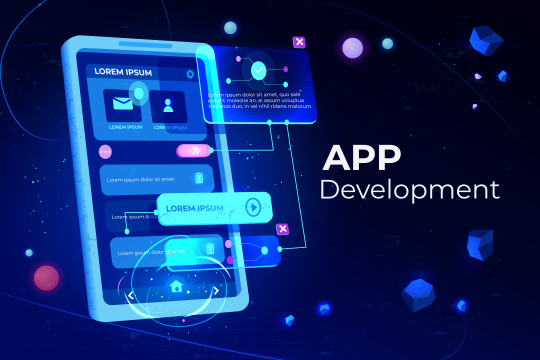
In today's hyper-connected world, a powerful mobile app is no longer a luxury for businesses – it's a necessity. From streamlining operations to engaging customers on a deeper level, the development of mobile apps has become a cornerstone of modern business strategy. If you're looking to expand your reach, enhance customer experience, or simply innovate, investing in app development mobile is a smart play.
Why Mobile Apps Are Essential for Modern Businesses
Think about your daily routine. How often do you reach for your phone? Chances are, quite a lot. Mobile applications provide a direct line to your audience, offering unparalleled convenience and accessibility. They build brand loyalty, drive sales, and provide invaluable data insights. Whether you're a startup or an established enterprise, a well-crafted app can differentiate you in a crowded market.
For many, the first step is to find mobile app developers who truly understand their vision and can translate it into a functional, intuitive product. This isn't just about coding; it's about strategic thinking, user experience design, and robust backend infrastructure.
Choosing the Right Mobile App Development Partner
When you decide to embark on this journey, the choice of your mobile app development company is paramount. You need a partner who offers expertise, reliability, and a deep understanding of your business goals.
Consider these key factors:
Customization is King: Look for a custom mobile app development company. Off-the-shelf solutions rarely fit perfectly. A bespoke app ensures your unique requirements are met, giving you a competitive edge.
Platform Proficiency: Does the firm specialize in your target platforms? For example, if reaching a vast user base is key, expertise in android mobile app development is crucial.
Industry Niche: If you're in retail, an ecommerce mobile app development company with proven experience can navigate the specific challenges and opportunities in online sales. They'll understand payment gateways, inventory management, and secure transactions.
Location: Many businesses prefer working with local experts. If you're based in Australia, you might search for a "mobile app development near me" or specifically a mobile app development company Sydney or a mobile app development Melbourne firm to ensure face-to-face consultations and better collaboration.
A reputable mobile app development firm does more than just write code. They act as a strategic partner, offering:
Consultation and Strategy: Helping you define your app's purpose, target audience, and key features.
UI/UX Design: Creating a user interface that's not only visually appealing but also incredibly easy and enjoyable to use.
Backend Development: Building the robust server-side infrastructure that your app needs to function seamlessly.
Testing and Quality Assurance: Rigorous testing to ensure a bug-free and smooth user experience.
Post-Launch Support: Maintenance, updates, and continuous improvement to keep your app relevant and performing optimally.
The overall development of mobile apps is an iterative process that benefits immensely from clear communication and a collaborative approach.
Your Mobile Future Starts Now
Whether you're aiming for a sleek enterprise solution or a captivating consumer-facing application, the path to mobile success begins with choosing the right partner. The market is ripe with opportunities for businesses ready to embrace mobile technology. By selecting an experienced mobile app development firm that understands your vision and the nuances of the digital landscape, you're not just building an app – you're building your digital future.
#custom mobile app development company#app development mobile#development of mobile apps#android mobile app development#mobile app development near me#find mobile app developers#mobile applications#UI/UX Design#Backend Development#Testing and Quality Assurance#Post-Launch Support
0 notes
Text
Backend system
4FOX Solutions is a leading backend development system in India. A Backend Administration platform is essential for managing various backend operations. Their backend administration platform is designed advanced website performed by effectively sorts and manages the client, order, content, and email.
0 notes
Text

Are your business apps and websites sluggish and not delivering optimal performance? The culprit might be poor backend development. At TheFinch Design, we have a team of dedicated and experienced professionals who can leverage cutting-edge technologies and solid strategies to build high-performance, scalable and reliable apps/websites. It’s time to put the pedal to the medal.
https://thefinch.design/back-end-development/
0 notes